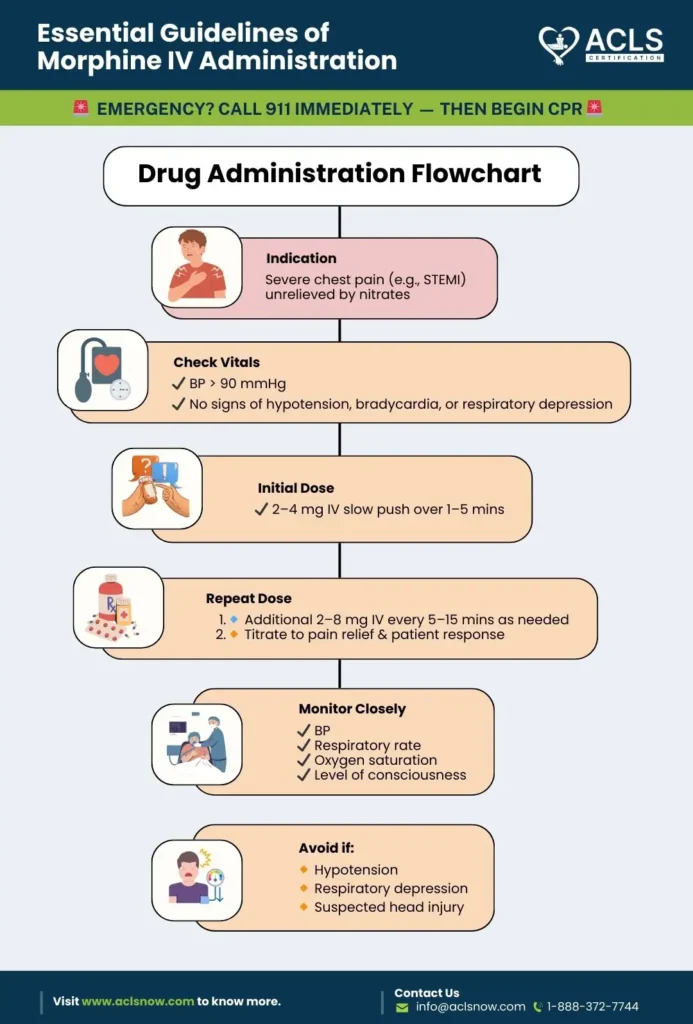Do you know that there are more than 356,000 out-of-hospital cardiac arrests (OHCA) annually in the U.S.? Of them, it is found that nearly 90% of them are fatal. While it’s essential to know the compressions and resume breaths, it is also important to know more. ACLS training is designed for healthcare professionals, particularly to handle cardiopulmonary emergencies. It includes skills such as responding to code blue situations and administering medications.
The certification is recommended for qualified healthcare professionals, such as doctors, registered nurses, and paramedics, who may need to intubate patients and administer intravenous drugs. Morphine sulfate is one such medication in ACLS training that plays a vital role in pain management during cardiac arrests (acute coronary syndrome) and post-resuscitation efforts. Read on to learn about its administration, dosage, and more!
Master ACLS Now
Get ACLS certified with confidence
What is Morphine Sulfate?
Morphine sulfate belongs to a group of drugs known as opioid analgesics. Administering the drug will influence the brain to change how your body feels and responds to the brain. Heart failure is a growing pandemic associated with a high burden of morbidity and mortality.
The use of opioids like morphine has a relieving effect on the key symptomatic discomfort associated with accurate heart failure. The rationale for the use of morphine for chest pain as a decongestive therapy is to relieve dyspnoea and anxiety in the victims.
Read More: ACLS Certification in San Diego
Morphine Sulfate in ACLS Training
ACLS training (Advanced Cardiovascular Life Support Certification) utilizes several drugs that are usually classified as ‘primary ACLS drugs’. These primary drugs are the medications used directly in the ACLS algorithm. Morphine sulfate is one such medication used to treat acute coronary syndrome in ACLS training.
Administering morphine sulfate intravenously aids in relieving distress, interrupting thrombosis, reversing ischemia, limiting infarct size, reducing cardiac workload, and preventing/treating any further complications. It greatly influences the outcome of ACS (acute coronary syndrome) with rapid diagnosis and proper treatment.
Read More: Know About ACLS | What is ACLS | Who needs ACLS Certificate
How to Give Morphine Sulfate Injection?
Depending on the condition of the victim, morphine sulfate is administered by injecting it into a vein, into a muscle, or under the skin. The drug should be prescribed only by medical professionals who have knowledge about the use of opioids and how to mitigate the associated risks with the medications.
IV Morphine Dosage
Are you wondering if 4 mg of morphine is a lot for chest pain? It is recommended to use the lowest effective dosages for the shortest duration, aligning with the individual patient’s treatment goals. There is no maximum dose for morphine in a palliative care setting, while typically, the dose should not exceed 200 mg in 24 hours.
Reserve titration of a higher dosage of morphine sulfate injection for adoption where lower doses are insufficiently effective. You should also consider the desired benefits of using a higher dose outweighing the substantial risk.
It is important to initiate the regimen for morphine sulfate IV push rate for each patient individually, taking their underlying cause and severity of pain, prior analgesic treatment, and response, along with the risk factors for addiction, abuse, and misuse, into account.
- In cardiac emergencies, the direct IV morphine dosage in adults should be between 0.1 mg and 0.2 mg per kg every four hours as required for pain management.
- Typically, the morphine dose for chest pain is available in 4 mg/mL, 8 mg/mL, and 10 mg/mL for intravenous administration. Remember not to stop the administration of morphine sulfate abruptly in a physically dependent patient, as it might result in adverse effects.
- Moreover, the healthcare professional should give the dosage based on the victim’s medical condition and the body’s response to the treatment. For instance, the children’s dosage of morphine sulfate will be predicted based on their weight.
- Don’t increase the prescribed dose; use it for a longer time than prescribed, or use it more often. ‘
- Ensure to stop the medication as directed in the training properly.
Morphine Sulfate IV Push Rate
Morphine IV push rate should be limited to use by a familiar professional for the management of respiratory depression. The drug should be injected slowly through intravenous administration for 4 to 5 minutes with the patient in the recumbent position. For consistent intravenous infusion of morphine, the appropriate IV morphine dosage should be 1-2 mg per hour in adults and adolescents over 12 years of age.
Safety Measures to Follow While Using Morphine Sulfate
Now that you have learned about morphine IV push, it’s time to know about the preventive measures while administering the drug.
- Healthcare professionals usually give preservative-free morphine sulfate into the area around the spinal cord (epidural) or into the fluid-filled space that contains the spinal cord (intrathecal). Remember, morphine as a pain medication for cardiac conditions works best when they are used at the initial occurrence of the symptoms.
- Before using the injection, check the product visually for particles or discoloration. If any are present, it is not advisable to use the liquid.
- Before injecting each dose, ensure that the site is cleaned with rubbing alcohol.
Risks and Side Effects of Morphine Sulfate
Morphine sulfate injection might expose people to risks of abuse, addiction, etc, which can ultimately lead to overdose and death. Therefore, it is critical to assess the victim’s risks before prescribing the injection regularly to cure the condition.
- Nausea, vomiting, constipation, dizziness, lightheadedness, drowsiness, increased sweating, or dry mouth can be the side effects of morphine injection.
- Ask the victim right away if they have experienced any serious side effects, like vision changes or severe abdominal pain, or observe them for seizures or shallow breathing.
- While the drug is administered to treat cardiac problems, can morphine cause chest pain? The continuous, unsupervised use of the drug will cause serious, life-threatening, or fatal respiratory depression.
To reduce the risk of such respiratory depression, it is vital to follow the proper dosing and titration of the morphine sulfate injection.
Precautions for Morphine Sulfate During Specific Conditions
Here are some precautions to follow while administering the drug for certain conditions.
- Cardiovascular Instability: High doses of morphine sulfate are excitatory. It is recommended to have naloxone injection and resuscitative equipment to be available immediately.
- Opioid-induced Hyperalgesia And Allodynia: OIH happens when an opioid analgesic paradoxically results in increasing the effect of pain or increasing the effect of sensitivity to pain. If the condition is suspected, make sure to carefully consider appropriately reducing the dosage of the currently administering opioid analgesic or opioid rotation.
- Life-threatening Respiratory Depression: Individuals with life-threatening respiratory depression and chronic pulmonary disease or those elderly or debilitated patients have to be monitored closely, especially at the time of initiation and titration.
- Adrenal Insufficiency: Once diagnosed, treat the condition with physiological replacement of corticosteroids, and when the victim of the opioids.
- Severe Hypotension: Monitor during dosage initiation and titration of morphine sulfate. It is not advisable to use the preservative-free morphine injection in patients struggling with circulatory shock.
- Increased Intracranial Pressure: It is important to monitor the patient with increased intracranial pressure, brain tumors, head injury, or impaired consciousness for sedation or any respiration depression.
- Use of Morphine Sulfate in Specific Population: Administering morphine sulfate or any opioid analgesic for an extended period in pregnant individuals might induce neonatal opioid withdrawal syndrome. It might also induce drug-associated risk for major congenital disabilities and miscarriage.
- Drug Interactions: Concomitant use of morphine sulfate with any other opioids with benzodiazepines or any other central nervous system (CNS) depressants like alcohol can lead to product sedation, respiratory depression, coma, and death. It is also recommended to avoid the use of preservative-free morphine as it might reduce the analgesic effect of the drug or precipitate withdrawal symptoms.
Alternatives to Morphine in ACLS
Sometimes, morphine will not suit the patient, and there are other drugs available that the provider can prescribe.
- One opioid drug is fentanyl, which works faster than morphine and is mainly indicated in emergencies where rapid pain relief is essential.
- Another one is nitroglycerin, mainly indicated for chest pains due to angina.
- Nitroglycerin dilates blood vessels and increases blood flow to the heart, therefore relieving chest pains.
- For patients primarily suffering from anxiety instead of pain, a doctor may prescribe Versed midazolam. Versed does not relieve any form of pain; however, it is effective at calming the anxious patient during cardiac emergencies.
Each of these options has its advantages and dangers, and the medicine is chosen according to the patient’s condition and requirements.
Be Prepared to Make A Difference in Emergency Situations!
Morphine sulfate plays a crucial role in Advanced Cardiac Life Support (ACLS) training and protocols. Its analgesic and anxiolytic properties make it invaluable in managing acute coronary syndromes and pulmonary edema. However, ACLS providers must be well-versed in its appropriate use, potential side effects, and contraindications. The emphasis on morphine sulfate in ACLS training ensures that healthcare professionals can effectively administer this medication in high-stress cardiac emergencies, potentially improving patient outcomes.
As medical knowledge evolves, ongoing education and updated protocols regarding morphine sulfate use in ACLS scenarios remain essential. By maintaining a thorough understanding of this medication’s role, ACLS providers can continue to deliver optimal care in critical cardiac situations. The training also demonstrates your ability to identify and treat life-threatening conditions.








